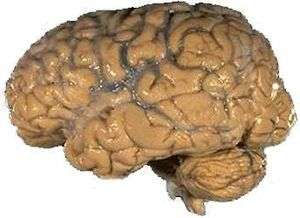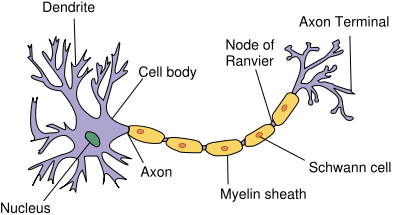Wikijunior:Human Body/Brain
< Wikijunior:Human BodyThe brain is the organ that harbors our selves, our thinking, feelings, personalities and consciousness. We conclude this from experiments that demonstrate activity of the brain. How the brain works in detail is a great mystery to this day for most of the aspects mentioned, however.
What does the brain look like?


The brain fills the interior of our skulls and is composed of several lobes (round shaped parts that are interconnected). There is an exterior part - the grey substance(grey matter) - and an interior part - the white substance (white matter), as revealed by a cross section.
The brain is mainly composed of neurons (cells that can transmit electrical signals) and supporting cells (glia cells). As for most other organs there are blood vessels and immune cells too. Neurons have a main body and many extensions.
Dendrites are extensions to receive signals and one single axon transmits electrical signals to other neurons. The main body is a bit darker than dendrites or axons and are predominantly located in the grey substance, thereby giving it its color.
What is the function of the brain?
The brain receives input from cranial nerves and the medulla. These signals are processed by our brain. You can actually feel it right now, because you consciously know, that you are reading this page - which is a conscious visual input.
Also you hear sounds, you feel emotions, you feel being touched, tickled and so on. All these are conscious reactions to input. Of course, we react to this input by changing our mood, moving or thinking. Body movements are being commanded by the brain through the nerves and the medulla, too. Cranial nerves and medulla therefore have fibers dealing with input and others that deal with output.
What organ system(s) is the brain connected with?
The brain is actually connected with almost every other organ of the body. We can sense the top of our head, our toe-tips and we can frown as well as walk. Also organs like the stomach, thymus or spleen are connected with the brain. We cannot feel these organs, which is an example of unconscious processing of input and output by the brain.
How does the brain interact with other parts of the body?
The brain connects to other organs by means of axons and dendrites. Electrical signals trigger reactions in connected organs, whereas sensory nerve endings (dendrites or other specialized structures) help collecting input. For example, in muscles electrical signals are converted into chemical signals eliciting muscular contraction via the sliding filament hypothesis.
How can you keep your brain healthy?
Exercising your brain will keep it in great shape and will help you to continue learning and become quicker in understanding. This includes reading, solving riddles or just being active: outdoors exploring nature, indoors doing sports. Watching TV, however, is passive and will not help you improving your brainy skills. Some sports like boxing or bungee jumping are known to damage neurons and you should avoid them.